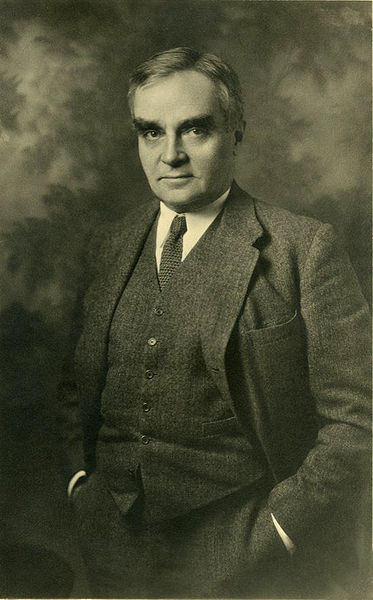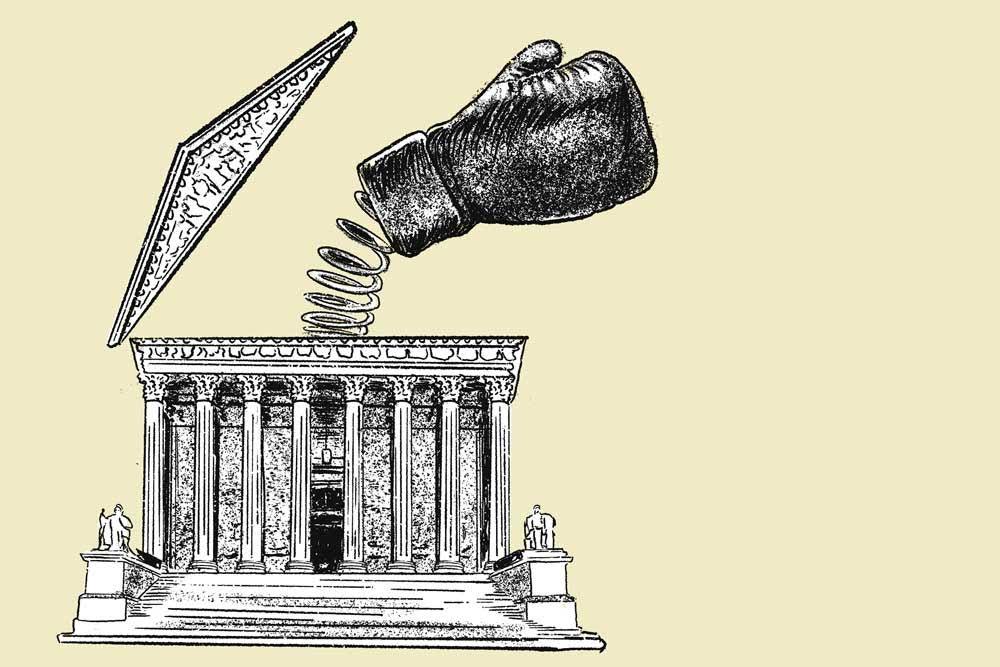Clear and Present Danger Test
Early in the 20th century, the Supreme Court established the clear and present danger test as the predominant standard for determining when speech is protected by the First Amendment.
The Court crafted the test — and the bad tendency test, with which it is often conflated or contrasted — in cases involving seditious libels, that is, criticisms of the government, its officials, or its policies. It would be superseded by the imminent lawless action test in the late 1960s.
Holmes introduces idea of clear and present danger test
Justice Oliver Wendell Holmes Jr. delivered the classic statement of the clear and present danger test in Schenck v. United States (1919): “The question in every case is whether the words used are used in such circumstances and are of such a nature as to create a clear and present danger that they will bring about the substantive evils that Congress has a right to prevent. It is a question of proximity and degree. When a nation is at war many things that might be said in time of peace are such a hindrance to its effort that their utterance will not be endured so long as men fight, and that no court could regard them as protected by any constitutional right.”
In Schenck, Justice Holmes clearly distinguished the clear and present danger test from the bad tendency test — which was predominant in English common law and would be articulated in Gitlow v. New York (1925) — when he stated that “in time of peace,” the pamphleteer and co-defendants “would have been within their constitutional rights.”
Distinction from bad tendency test

The bad tendency test provides that when the facts of a case indicate that the communicator intended a result that the state has prohibited, the court may reasonably assume that the communication has a tendency to produce that result.
Furthermore, on the basis of that tendency, the court may punish the communicator for violation of the law. For example, if a pamphleteer urges conscripts to resist military conscription, and if a law criminalizes noncompliance, judges may rightfully conclude that the pamphlet has a tendency to encourage violations of the law and therefore convict the pamphleteer.
In contrast to the clear and present danger test, the bad tendency test proposes no distinction based upon circumstances. The Supreme Court observed in Gitlow, “Freedom of speech and press . . . does not protect publications or teachings which tend to subvert or imperil the government or to impede or hinder it in the performance of its governmental duties” (italics added). The bad tendency test protects only innocuous speech; it criminalizes all seditious libels.
Holmes dissent says imminent danger must be present
Justice Holmes ultimately found the clear and present danger test as articulated in Schenck insufficient to protect basic constitutional rights. Thus, in his dissent later in the year in Abrams v. United States (1919) he wrote that “we should be eternally vigilant against attempts to check the expression of opinions . . . unless they so imminently threaten immediate interference with the lawful and pressing purpose of the law that an immediate check is required to save the country.”
Thus, he elevated the danger requirement from “clear” to “imminent” interference with legal action.
Justice Louis D. Brandeis further elaborated upon the test in his concurring opinion (which Holmes joined) in Whitney v. California (1927), when he argued that the “evil apprehended” as a result of expression should be “so substantial as to justify the stringent restriction apprehended by the legislature.”
Adoption of clear and present danger test
The clear and present danger test was not accepted by a majority of the Supreme Court until Herndon v. Lowry (1937), when Justice Owen J. Roberts invoked it while rejecting the bad tendency test as an appropriate standard for identifying the protections of the First Amendment.
From 1940 to 1951, the Court employed the clear and present danger test to decide 12 cases.
In American Communications Association v. Douds (1950), however, the Court had begun to switch gears when it assessed the constitutionality of a statute aimed not at political expression but at political strikes in the communications industry.
For the majority, Chief Justice Frederick M. Vinson wrote, “When the effect of a statute or ordinance upon the exercise of First Amendment freedoms is relatively small and the public interest to be protected is substantial, it is obvious that a rigid test requiring a showing of imminent danger to the security of the Nation is an absurdity.”

“Gravity of evil” introduced as a balance test
Vinson then reconstructed the clear and present danger test: “[N]ot the relative certainty that evil conduct will result from speech in the immediate future, but the extent and gravity of the substantive evil must be measured by the test laid down in the Schenck case.”
Judge Learned Hand of the Second Circuit Court of Appeals adapted the Vinson revision in United States v. Dennis (1950): “Clear and present danger depends upon whether the mischief of the repression is greater than the gravity of the evil, discounted by its improbability.” Vinson embraced this rephrasing when Dennis was appealed to the Supreme Court in Dennis v. United States (1951).
Professor Samuel Krislov wrote that the clear and present danger standard had been transformed into a balancing test, “so completely blurred” that it served only to provide “apologetic acceptance of all legislative action” (p. 88).
Justices Hugo L. Black and William O. Douglas agreed.
When Brandenburg v. Ohio (1969), reached the Court, Black demanded that Justice Abe Fortas remove all references to the test from his draft opinion for a unanimous Court. Fortas refused, but resigned from the Court before the announcement of the decision in Brandenburg.
“Imminent lawless action” test supplants “clear and present danger” test
Justice William J. Brennan Jr. redrafted the per curiam opinion, substituting for clear and present danger a new standard (Schwartz 1995: 27): “The constitutional guarantees of free speech and free press do not permit a State to forbid or proscribe advocacy of the use of force or law violation except where such advocacy is directed to inciting or producing imminent lawless action and is likely to incite or produce such action.”
The imminent lawless action test has largely supplanted the clear and present danger test. The clear and present danger remains, however, the standard for assessing constitutional protection for speech in the military courts.
This article was originally published in 2009. Richard A. “Tony” Parker is an Emeritus Professor of Speech Communication at Northern Arizona University. He is the editor of Speech on Trial: Communication Perspectives On Landmark Supreme Court Decisions which received the Franklyn S. Haiman Award for Distinguished Scholarship in Freedom of Expression from the National Communication Association in 1994. cited https://mtsu.edu/first-amendment/article/898/clear-and-present-danger-test
To Learn More…. Read MORE Below and click the links
Learn More About True Threats Here below….
We also have the The Brandenburg v. Ohio (1969) – 1st Amendment
CURRENT TEST = We also have the The ‘Brandenburg test’ for incitement to violence – 1st Amendment
We also have the The Incitement to Imminent Lawless Action Test– 1st Amendment
We also have the True Threats – Virginia v. Black is most comprehensive Supreme Court definition – 1st Amendment
We also have the Watts v. United States – True Threat Test – 1st Amendment
We also have theClear and Present Danger Test – 1st Amendment
We also have theGravity of the Evil Test – 1st Amendment
We also have the Elonis v. United States (2015) – Threats – 1st Amendment
Learn More About What is Obscene….
We also have the Miller v. California – 3 Prong Obscenity Test (Miller Test) – 1st Amendment
We also have the Obscenity and Pornography – 1st Amendment
Learn More About Police, The Government Officials and You….
We also have theBrayshaw v. City of Tallahassee – 1st Amendment – Posting Police Address
We also have thePublius v. Boyer-Vine –1st Amendment – Posting Police Address
We also have the Lozman v. City of Riviera Beach, Florida (2018) – 1st Amendment – Retaliatory Police Arrests
We also have the Nieves v. Bartlett (2019) – 1st Amendment – Retaliatory Police Arrests
We also have the Freedom of the Press – Flyers, Newspaper, Leaflets, Peaceful Assembly – 1st Amendment
We also have the Insulting letters to politician’s home are constitutionally protected, unless they are ‘true threats’ – 1st Amendment
We also have the Introducing TEXT & EMAILDigital Evidencein California Courts – 1st Amendment
We also have the First Amendment Encyclopedia very comprehensive – 1st Amendment
ARE PEOPLE LYING ON YOU? CAN YOU PROVE IT? IF YES…. THEN YOU ARE IN LUCK!
We also have the Penal Code 118 PC – California Penalty of “Perjury” Law
We also have theFederal Perjury – Definition by Law
We also have the Penal Code 132 PC – Offering False Evidence
We also have the Penal Code 134 PC – Preparing False Evidence
We also have thePenal Code 118.1 PC – Police Officers Filing False Reports
We also have the Spencer v. Peters– Police Fabrication of Evidence – 14th Amendment
We also have the Penal Code 148.5 PC – Making a False Police Report in California
We also have the Penal Code 115 PC – Filing a False Document in California
Know Your Rights Click Here (must read!)
Under 42 U.S.C. $ection 1983 – Recoverable Damage$
42 U.S. Code § 1983– Civil Action for Deprivation of Right$
$ection 1983 Lawsuit – How to Bring a Civil Rights Claim
18 U.S. Code § 242 – Deprivation of Right$ Under Color of Law
18 U.S. Code § 241 – Conspiracy against Right$
$uing for Misconduct – Know More of Your Right$
Police Misconduct in California – How to Bring a Lawsuit
New Supreme Court Ruling – makes it easier to sue police
RELATIONSHIPWITH YOURCHILDREN& YOURCONSTITUIONAL RIGHT$ + RULING$
YOU CANNOT GET BACK TIME BUT YOU CAN HIT THOSE PUNKS WHERE THEY WILL FEEL YOU = THEIR BANK
We also have the 9.3 Section 1983 Claim Against Defendant as (Individuals) — 14th Amendment thisCODE PROTECTS all US CITIZENS
We also have the Amdt5.4.5.6.2 – Parental and Children’s Rights 5th Amendment thisCODE PROTECTS all US CITIZENS
We also have the 9.32 – Interference with Parent / Child Relationship – 14th Amendment thisCODE PROTECTS all US CITIZENS
We also have the California Civil Code Section 52.1Interference with exercise or enjoyment of individual rights
We also have the Parent’s Rights & Children’s Bill of RightsSCOTUS RULINGS FOR YOUR PARENT RIGHTS
We also have a SEARCH of our site for all articles relatingfor PARENTS RIGHTS Help!
Contesting / Appeal an Order / Judgment / Charge
Options to Appealing– Fighting A Judgment Without Filing An Appeal Settlement Or Mediation
Cal. Code Civ. Proc. § 1008 Motion to Reconsider
Penal Code 1385 – Dismissal of the Action for Want of Prosecution or Otherwise
Penal Code 1538.5 – Motion To Suppress Evidence in a California Criminal Case
CACI No. 1501 – Wrongful Use of Civil Proceedings
Penal Code “995 Motions” in California – Motion to Dismiss
WIC § 700.1 – If Court Grants Motion to Suppress as Evidence
 Epic Criminal / Civil Rights SCOTUS Help – Click Here
Epic Criminal / Civil Rights SCOTUS Help – Click Here
 Epic Parents SCOTUS Ruling – Parental Rights Help – Click Here
Epic Parents SCOTUS Ruling – Parental Rights Help – Click Here

